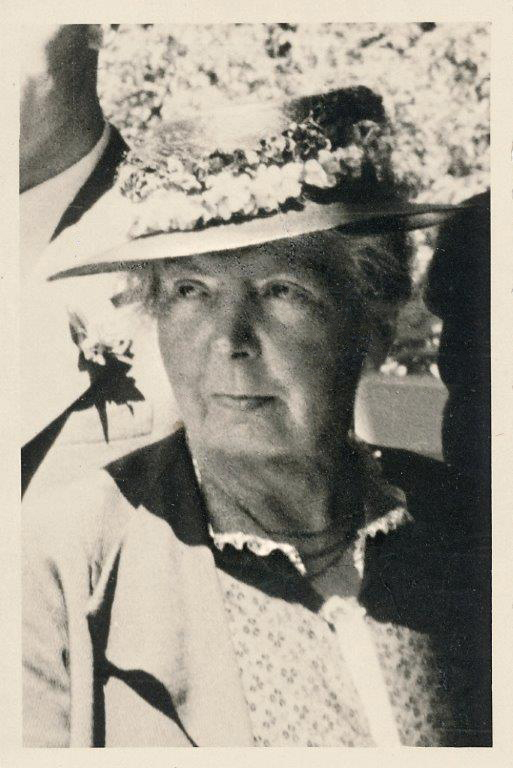
Frieda Lauterburg (1877- 1943), pottery paintress in Langnau. Photo from family collection.
Works by Frieda Lauterburg in CERAMICA CH
Andreas Heege, Susan Roethlisberger (Langnau), 2022
The following is largely based on Frieda Lauterburg’s own letters, which have been kept in the family archive.
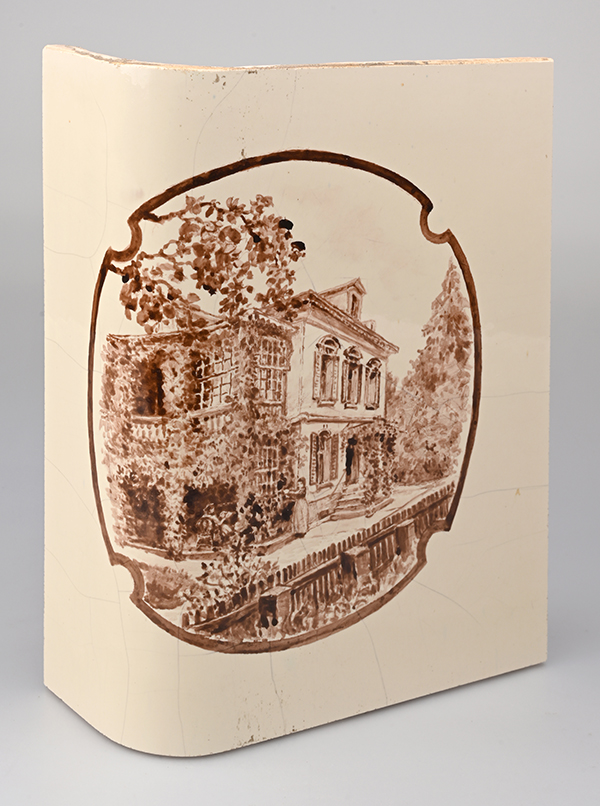
Stove tile painted by Frieda Lauterburg with a depiction of her parents’ villa at 5 Schlossstrasse, Langnau, Canton of Bern. From a stove that once stood in the house of her sister, Anna Joost-Lauterburg, 3 Dorfbergstrasse. In private ownership.
Maria Frieda Lauterburg, who was better known as Frieda Lauterburg, was born on 17th August 1877 as the oldest of seven children of Karl Alfred Lauterburg (1847-1914) and Maria Sophia Lauterburg (1855-1923) in the Lauterburg villa at 5 Schlossstrasse in Langnau, Canton of Bern. Frieda’s father co-owned the canvas factory Lauterburg & Joost in Langnau. He was a very talented draughtsman and was well respected among experts for his ornithological knowledge. Frieda’s mother was a pastor’s daughter from Lützelflüh and ensured that her children received a god-fearing and art-loving upbringing. Having completed secondary school, Frieda went on to boarding school in Lutry and later attended the school of domestic science in Worb. Because Frieda had a curved spine, she and a sister seven years her junior were sent to Zurich for a lengthy period of time to receive medical treatment at the institution that preceded the Balgrist Hospital. Unfortunately, the intervention came too late for Frieda who was left with a hunched back all her life; her sister’s treatment, however, was successful.
Upon her return from Zurich Frieda appears to have stayed at home to support her parents. In October 1901 she passed the entrance exam to attend the vocational school in Zurich. Her teachers recognised her talent and, with the support of her parents, encouraged her to enrol in a four-year-long programme studying design, rather than just doing a short course. At that time, it was quite unheard of for a girl “from a good family” to take up a profession. In this respect the Lauterburgs were very openminded. On the other hand, they insisted until the day they died that Frieda should seek permission to go on even the smallest outing.
In May 1902, after the long spring holidays, she began to find designing patterns and point paper rather tedious, so she asked her parents to give her 75 francs per month to attend a course in landscape drawing. This would mean sacrificing one afternoon of pattern designing each week. In the same letter she also informed her parents that she had decided to study for only two more years.
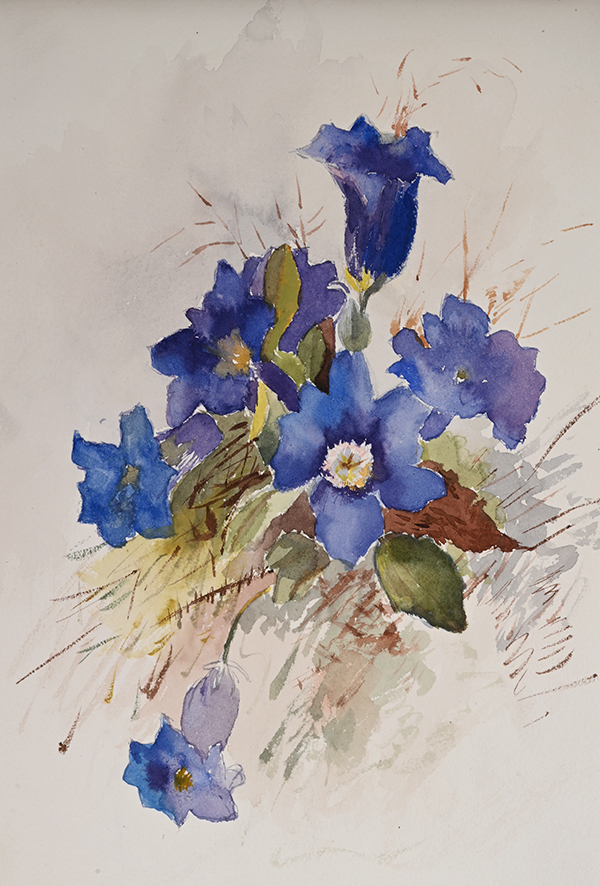
From one of Frieda Lauterburg’s sketchbooks, in private ownership.
She had very good grades in her first semester, earning 5.6 (of 6) in flower drawing and 6 in pattern designing.
In her spare time, Frieda enjoyed taking and developing photographs. Unfortunately, the pictures did not turn out very well and were usually out of focus. She also enjoyed attending the many concerts and theatre plays that were on offer in Zurich.
In January 1904, Herr Brügger, one of her Zurich teachers, told her that he was going to take up a position in St. Gallen and that he would like her to change schools as well. He advised her that pattern designing would not be part of the curriculum there but instead there would only be painting and drawing. After she had moved to St. Gallen, she wrote to her parents that students had Mondays and Tuesdays off and that she had enrolled in embroidery classes on one of the afternoons instead. On her days off, she spent a lot of time drawing, and she also began to create etchings. She finished her studies in St. Gallen in the spring of 1905; none of her letters make it clear whether or not she sat her final exams.
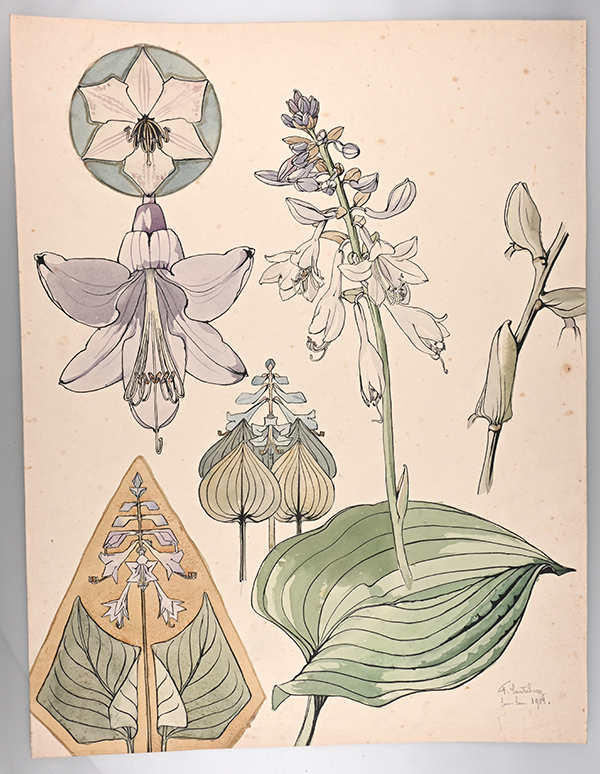
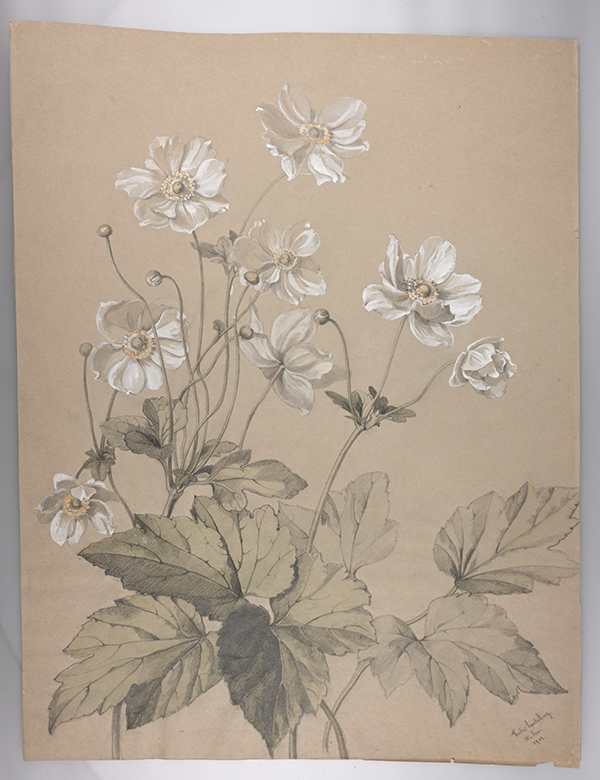
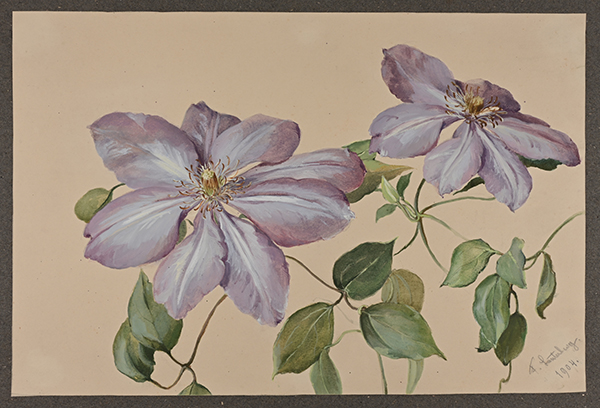

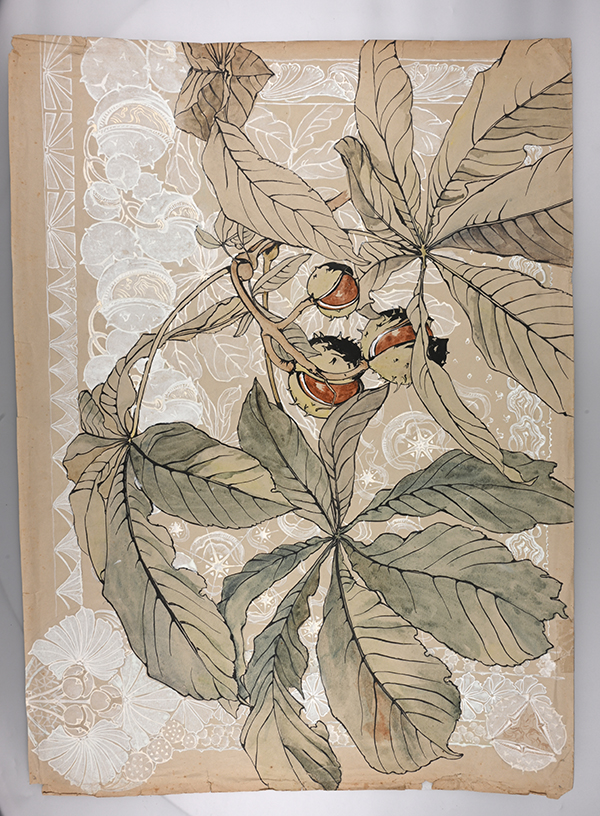
Frieda Lauterburg, drawings of plants 1900-1905, Langnau Regional Museum and in private ownership.
A series of drawings of plants from her time in Zurich and St. Gallen have survived and they clearly show what a talented draughtsperson she was (summer exhibition at KulturRaum Langnau, 2010).
From October 1906 to 1st January 1907, she worked at the Vallotton workshop in Geneva, thinking that she would receive further training in pottery painting. Unfortunately, however, her work there was all serial production, which required technique but no creativity. Also, 9-hour-long working days, which often lasted until 11 pm, were not at all to her liking.
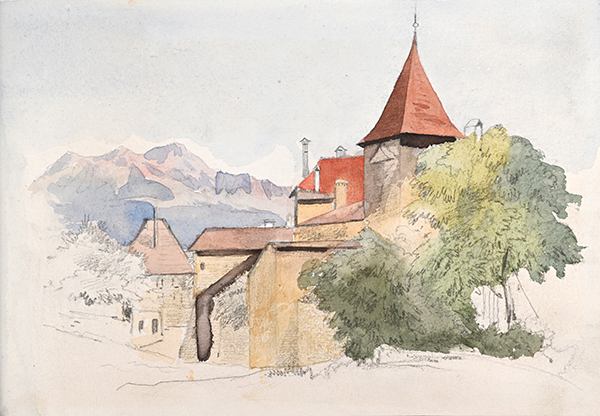
From one of Frieda Lauterburg’s sketchbooks, in private ownership.
A short while later, having become increasingly bored with copying, she showed her landscape pictures to her employer, who promptly gave her the task of painting her own designs on wall plates. Two weeks later she wrote to her sister about the soul-destroying work of painting the same motif on 15 little bowls. Moreover, the workshop was not particularly comfortable to work in. She complained about the cold and asked her family to send a foot muff and a cushion for her stool. She was paid 90 francs per month for her work.
In early 1907, things at the Vallotton workshop went awry. Monsieur Vallotton had apparently gone skiing and Madame Vallotton was in a bad mood. Nobody was taking charge, and nobody was following orders. One of the best workers was fired and Frieda handed in her notice for the end of January. In a letter home she wrote that she was planning to stay on in Geneva for a few more days to work on her own pieces, as she was hoping to participate in an industry and trade exhibition in Langnau in the summer. In one of her letters, she casually mentioned that she was thinking of learning how to throw pottery. In late January 1907, before returning home, she and a colleague visited the faience factory in Nyon where she was given a guided tour by one of the painters from Langnau who was working there.

Official postcard from the pottery exhibition at the Langnau Industry and Trade Exhibition of 1907.
In June 1907, Frieda was the only woman selected to join the committee of the trade exhibition, alongside various prominent Langnau personalities. Emil Aeschlimann intended to show a selection of old Langnau ceramics at the exhibition, which would be received on loan from the Swiss National Museum and the Historical Museum in Bern.
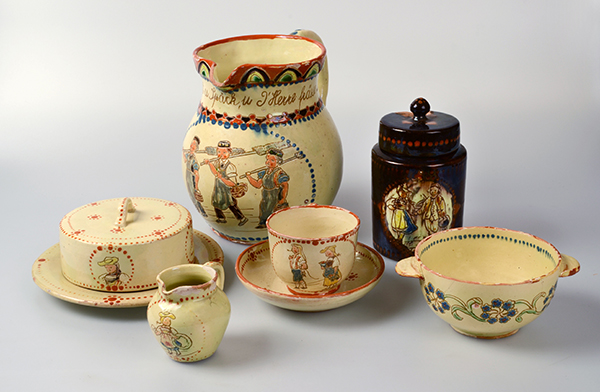

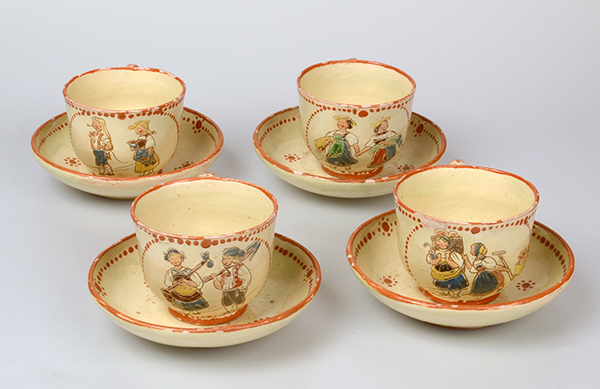
Pottery made by Frieda Lauterburg, probably at least in part in 1907 for the Langnau Industry and Trade Exhibition (Langnau Regional Museum).
Frieda herself had already produced a large selection of pieces, which she was hoping to exhibit. One of her letters mentions that the ceramics, once she was finished painting them, were being sent to Nyon for firing. In July 1907, she exhibited her works alongside Johann Röthlisberger at the Industry and Trade Exhibition in Langnau (Der BUND 2nd July 1907; NZZ 3rd July 1907).
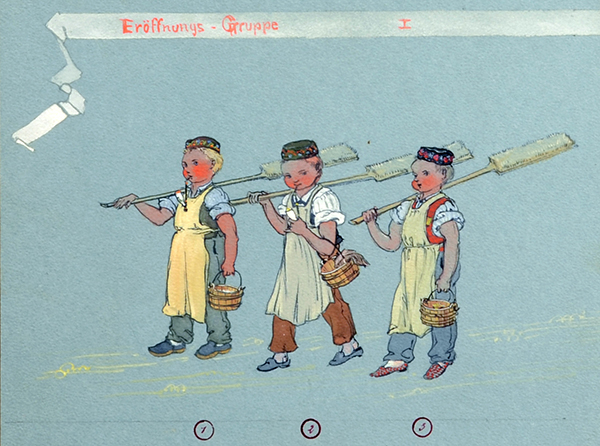
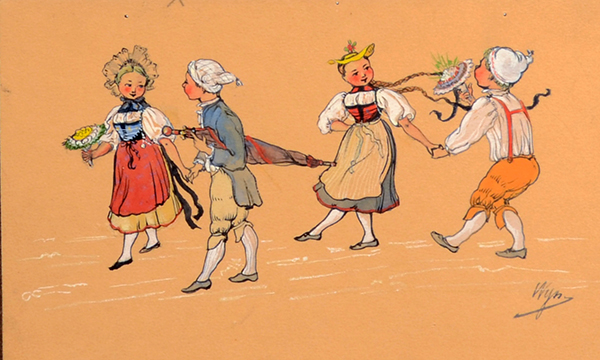
Designs by Paul Wyss showing the children’s parade at the Cantonal Marksmen’s Festival in Langnau in 1906, originals in the Langnau Regional Museum.
Her motifs were inspired by the designs of Paul Wyss, a pottery instructor from Bern, for instance his scenes from the children’s parade at the Cantonal Marksmen’s Festival in Langnau in 1906 (which had also been printed and sold as a series of postcards).
Unfortunately, the pieces that have survived only bear her own signature, so that we do not know who assisted her in making the service shown above; it is not really plausible to assume that she could have mastered the throwing of such perfect forms in such a short period of time. It is unlikely that Frieda Lauterburg made her own vessels; she probably mainly painted pottery, and from 1911/12, it was fired at the workshop of Adolf Gerber at 3 Güterstrasse in Langnau. Before that she possibly collaborated with Johann Röthlisberger who had a workshop on Oberstrasse, since they both exhibited their wares at the Langnau Trade Exhibition in 1907. Because many of her shapes clearly differed from the usual range of “Gerber ware”, it is possible that she specified the shapes by way of sketches and then slipped, incised and painted the leather-hard vessels before signing them, which would explain the often-seen tears around the edges of the signatures (see above). Unfortunately, her estate does not contain any sketches of vessel shapes or decorations.
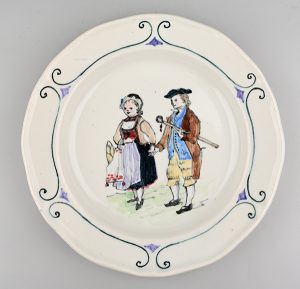
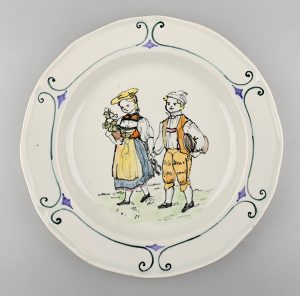

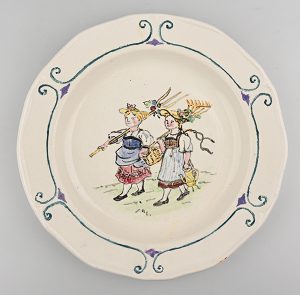
Unmarked refined white earthenware plates with the underglaze painted mark “FL” for Frieda Lauterburg.
It is, of course, also possible that the ceramics that were sent to Nyon for glazing and firing were painted and unmarked biscuit-fired refined white earthenware vessels like those that have survived as part of a private collection in Langnau. Like the painted stove tiles these pieces also show the children’s parade inspired by Paul Wyss.
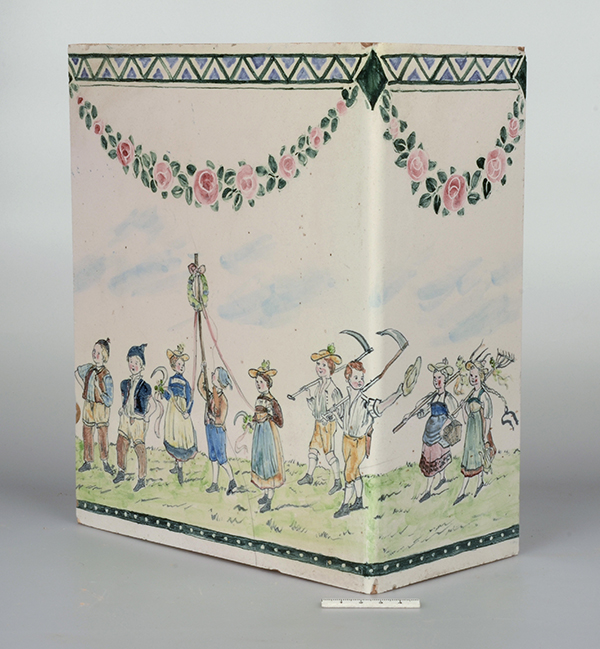
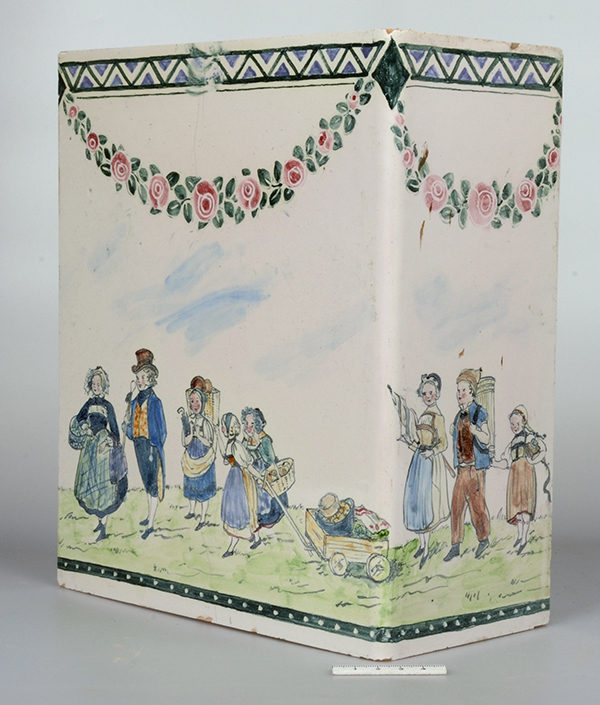
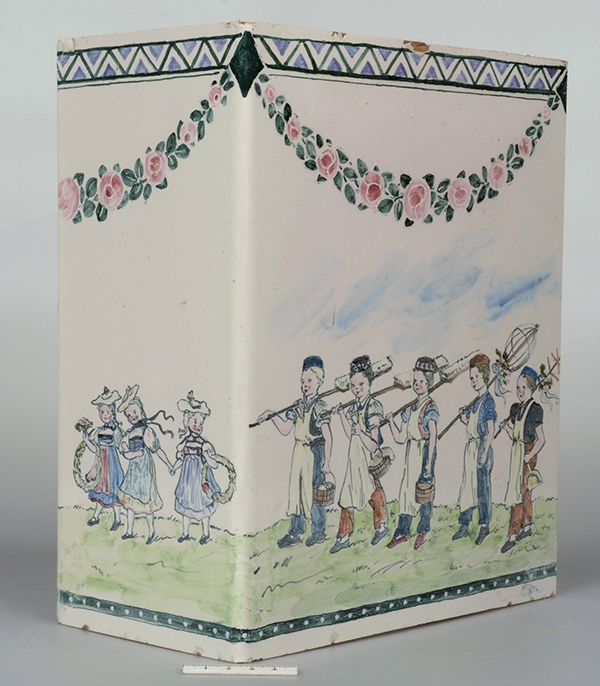
Remains of a dismantled tiled stove from Schlossstrasse (possibly 1 or 3 Schlossstrasse, Berger Villa) painted by Frieda Lauterburg with scenes from the children’s parade at the Cantonal Marksmen’s Festival in Langnau in 1906, inspired by designs by Paul Wyss.
In 1909 Frieda Lauterburg painted various tiled stoves for houses on Schlossstrasse in Langnau, including her parents’ home, the “Lauterburg Villa” (5 Schlossstrasse ) and the villas of their neighbours, the Berger family of wine merchants (1 and 3 Schlossstrasse). We do not know who fired the tiles, and whether the workshop was in Langnau or in one of the neighbouring villages or towns. The remnants of the stove at 5 Schlossstrasse survive in situ and show the children’s parade at the Cantonal Marksmen’s Festival in Langnau in 1906.
Both at the time and later (see below), she used blank tiles made by Kohler & Grimm or Kohler AG, a tiled stove manufacturer in Bienne (set up in 1898: Illustrierte schweizerische Handwerker-Zeitung : unabhängiges Geschäftsblatt der gesamten Meisterschaft aller Handwerke und Gewerbe, Vol. 14, 1898, 536).
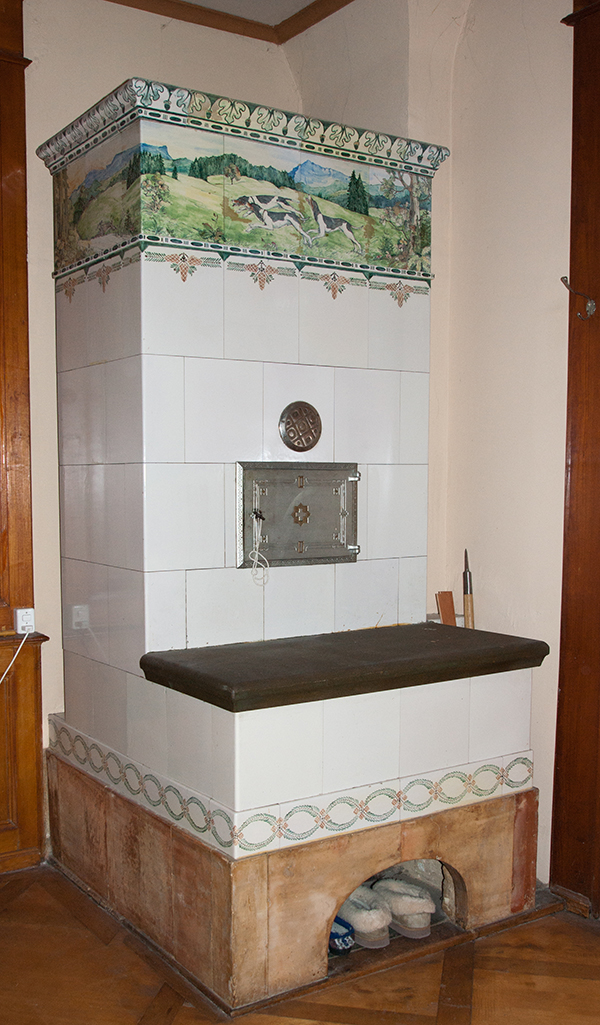
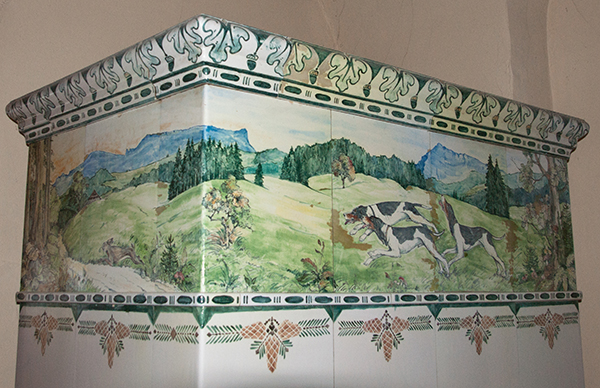
Tiled stove at 7 Schlossstrasse in Langnau.
In May 1909, Frieda and a distant cousin travelled to northern France. The same year she sent pottery to Zurich to be displayed at a regional exhibition of the trade association and painted a stove with hunting scenes for Hans Zürcher, a neighbour in Langnau at 7 Schlossstrasse.

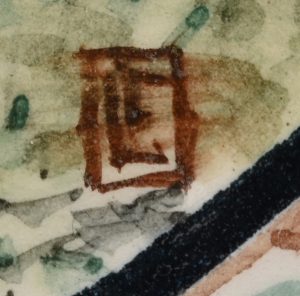
Residence of Anna and Ernst Joost-Lauterburg, 3 Dorfbergstrasse. In private ownership in Langnau.
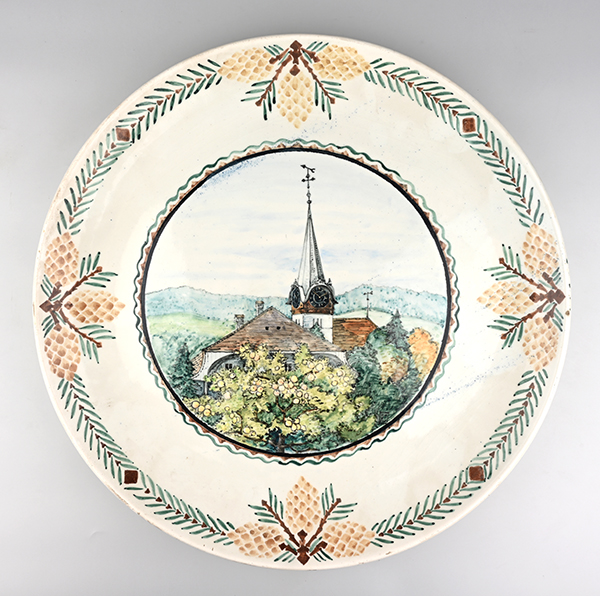
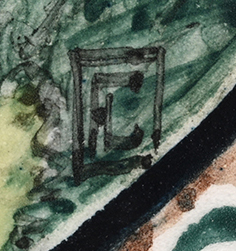
View of the church in Langnau. In private ownership in Langnau.
Based on the fir branch and cones motif on the stove, we can assume that two signed refined white earthenware plates with the same pattern in underglaze brushwork were made during the same period.
From 1909 onwards, she attended training courses two days a week at the School of Ceramics in Bern; in the winter semester 1910/1911 she enrolled as a student alongside Emil Loder (Steffisburg, later Lucerne), Adele Schwander (who worked as a paintress for potters like Bendicht Loder-Walder, Heimberg) and Elisabeth Strasser. She stayed in Bern until the winter semester 1911/1912 and during that time she also got to know Anna Müller (who was training as a porcelain paintress) and Adolf Schweizer (ceramicist from Steffisburg) (Messerli 2017, 228).

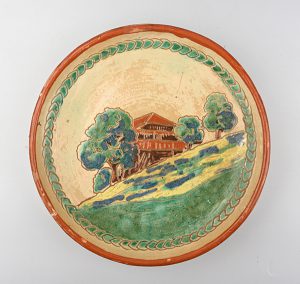
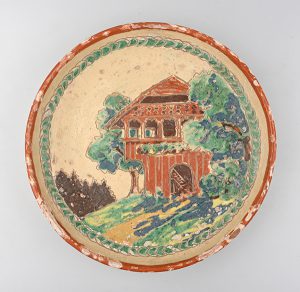

Small plates with landscape depictions made by Frieda Lauterburg, in private ownership in Langnau.
In a letter from 1909/1910 she wrote that she had “made pots” and painted small plates and bowls with landscape scenes.

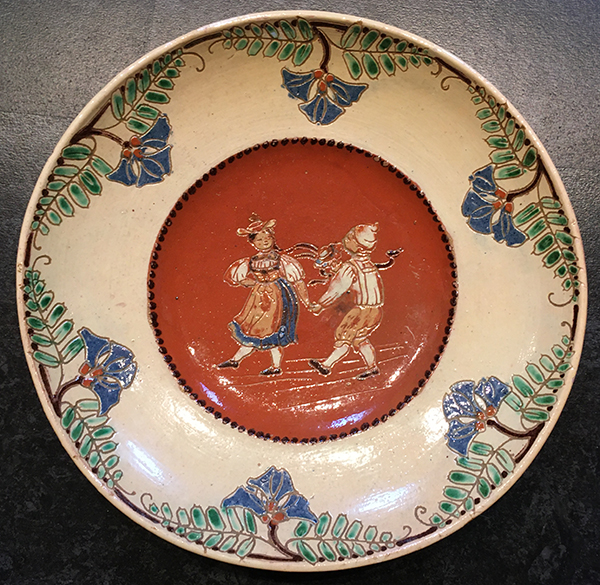
Pottery made by Frieda Lauterburg, in private ownership.
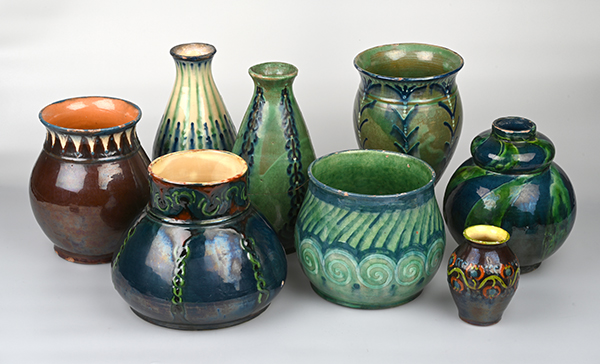
Pottery made by Frieda Lauterburg, in the collection of the Langnau Regional Museum.
In January 1911 she was paid 52 francs for pottery she sold at an exhibition in Bienne. Because Frieda Lauterburg signed her ceramics but did not date them, we have no way of knowing what exactly she produced during those years. The designs that have survived, however, are similar to those made by other pottery makers working around the same time in Langnau and in the Heimberg-Steffisburg region.
In March 1911 she travelled to North Africa for an extended period of time with a distant cousin. In 1912 and 1913, she collaborated with the Hubacher lithographic studio in Bern to publish a print edition of some of her drawings. It is not clear if this work was ever completed. In 1914, her father died and she continued to live in the big house on Schlossstrasse with her mother and a maid. The same year she participated in a collective exhibition of Langnau potters at the National Exhibition in Bern (Kiefer 1914, 74; also Der BUND, 9th October 1914), though we cannot say what she exhibited there. By 1915 she was back making pottery for an exhibition in Geneva and also sold many of her works.
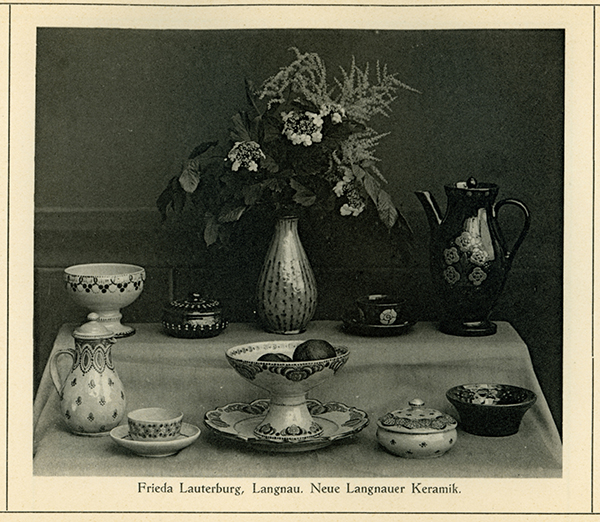
Pottery by Frieda Lauterburg in 1916; in: Franziska Anner, Die kunstgewerbliche Arbeit der Frau in der Schweiz, Chur 1916, Pl. 40.
Her work appears to have been known and regarded among a wide circle of active craftspeople, as demonstrated by the fact that she was included in a book on “Die kunstgewerbliche Arbeit der Frau in der Schweiz” [The arts and crafts created by women in Switzerland] published in 1916, alongside Elisabeth Eberhardt, Elisabeth Gött-Strasser, Nora Gross and Anna Müller.
She continued to decorate tiled stoves, often using designs by Paul Wyss, some of which still survive today.

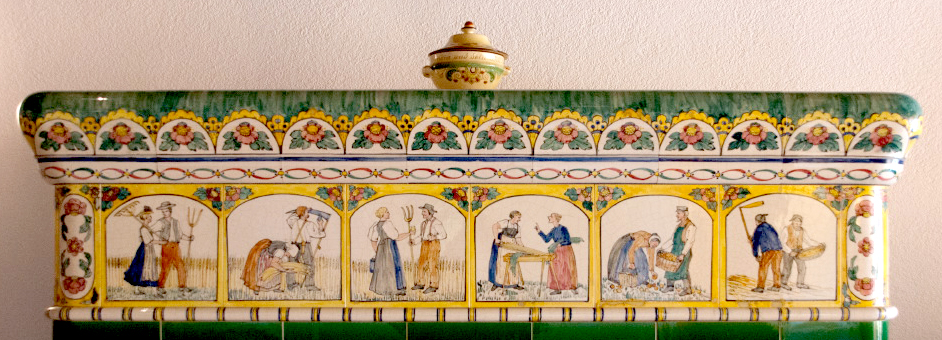
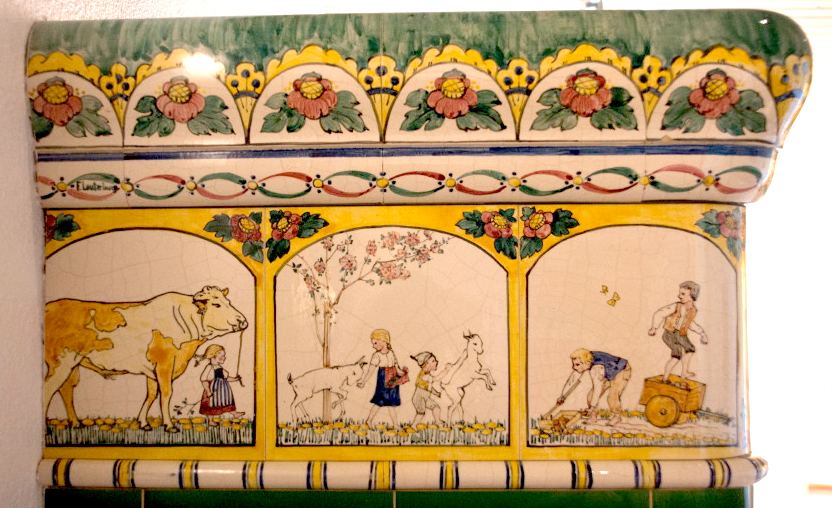
Tiled stove in Langnau, Lenggen, signed “F. Lauterburg”.

Signed “P. Wyss”.
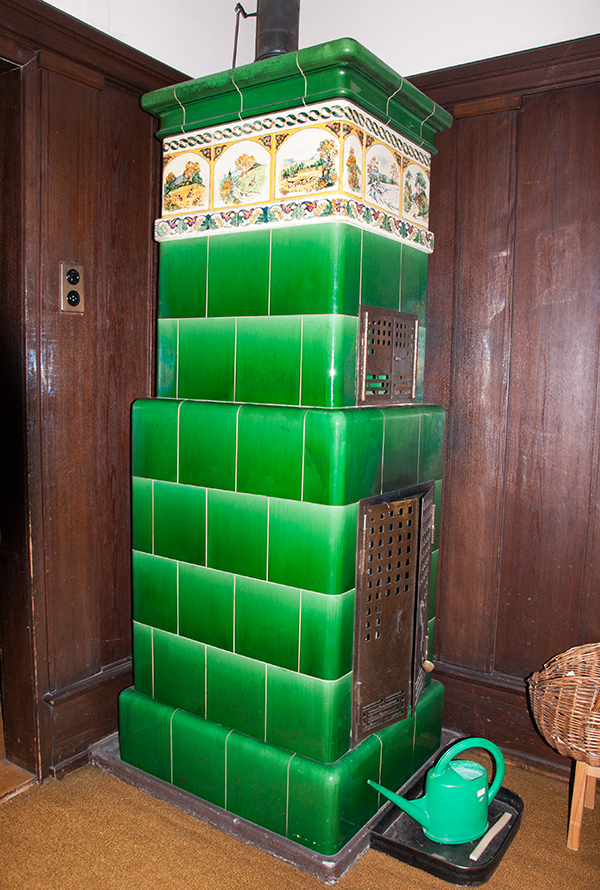
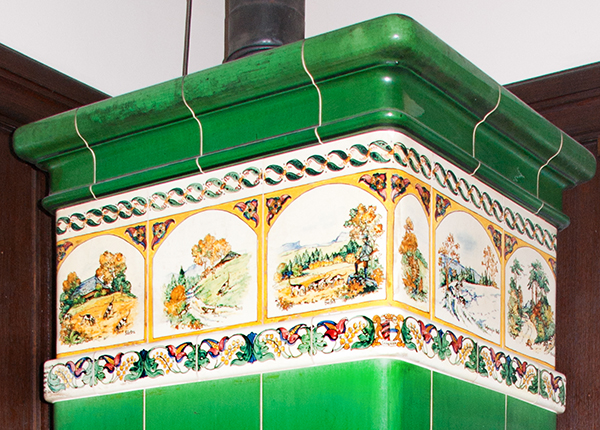
Tiled stove from 1918/1919 painted by Frieda Lauterburg, 7 Schlossstrasse in Langnau.
In 1919, an entire set of stove tiles, which were probably intended for another stove with hunting scenes for the villa of neighbour Hans Zürcher, were misfired, and she found it rather difficult to redo the work. That is probably why the stove has two dates; 1918 for when the order was placed and 1919 for when the work was completed (on a corner tile with a coat of arms).
The post-war years were very busy for Frieda Lauterburg. On the one hand her mother was in poor health and was often away from home, either in hospital or convalescing at a health resort. On the other, at least two of her sisters’ four boys came to convalesce at the villa on Schlossstrasse. The sister, a concert singer in Vienna, often spent summers in Langnau along with the entire family. At other times, Frieda went to Vienna to look after her sister’s children when she was away on tour. During this period, her letters made no mention of her ceramic work. Instead, she was busy singing with the local choir and working for various charitable organisations in the village. It was not until 1922 that she wrote about finishing stove tiles with bird motifs, which meant that the stove was then ready to be installed in her own home on Schlossstrasse (this may be the stove that has survived). In late 1923, her mother died after a long illness and Frieda was left to live alone in the big house, where she continued to make sure the family remained close.
Renovation work carried out on her parents’ house in the 1930s appears to have felt like a catastrophe to Frieda. The Lauterburg family firm moved its offices from Bärau to Langnau and into the ground floor of the villa on Schlossstrasse. An even bigger shock came when she was told that a nephew and his family wished to move into her apartment, and she found herself desperately searching for a new home. Luckily, she was able to move into a new apartment, which was practically identical, including her beloved veranda, in the neighbouring villa of the Berger family, where she continued to enjoy the same lifestyle as before
A trip to Greece in 1927 inspired her to go back to designing pottery. However, she was not very happy with the shapes the potter (whose name she does not mention, unfortunately) created on the basis of her sketches. She did, however, participate in an exhibition in Geneva that year (Der Bund, volume 78, issue 395, 14th September 1927).
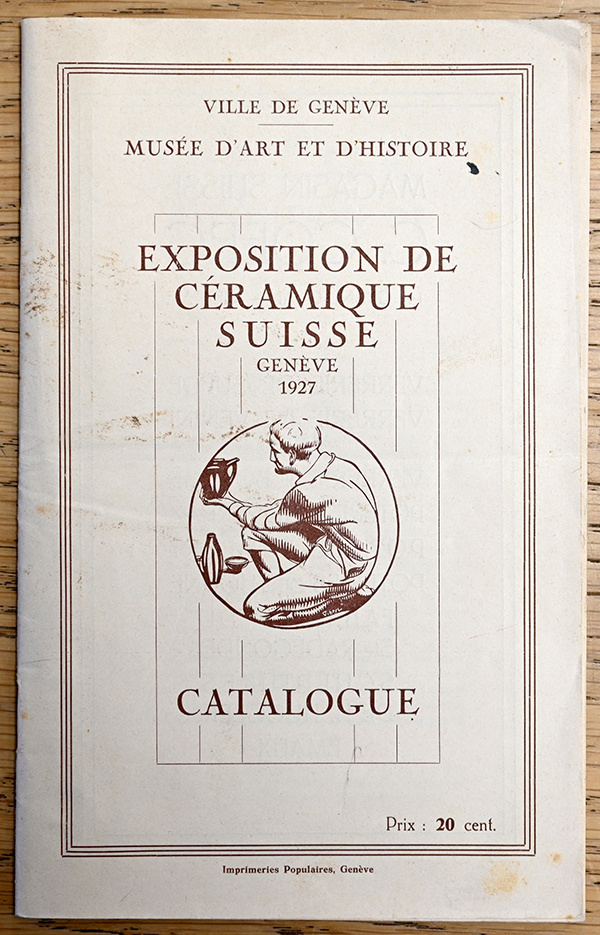
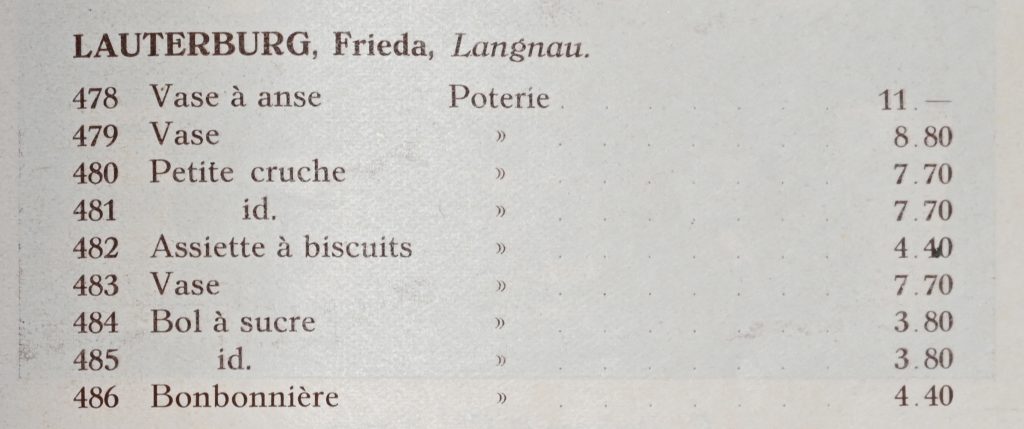
In 1928 she exhibited at the Saffa (Swiss Exhibition of Women’s Work, Bern 1928).
She often went for walks in the area, bringing along her folding chair, artists’ paraphernalia and parasol to paint or draw. In 1930, her letters mentioned a misfired cachepot. She also created more etchings.
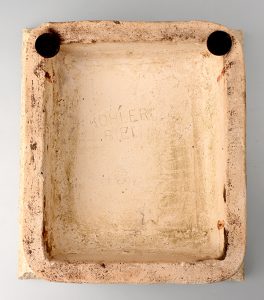
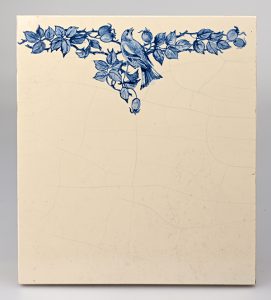
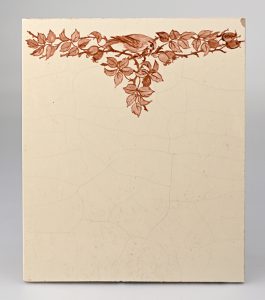
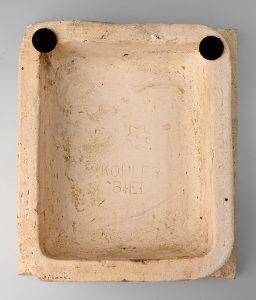
It is possible that she decorated further stoves with bird motifs in the 1930s for the home of her sister, Anna Joost-Lauterburg at 3 Dorfbergstrasse, as Susan Röthlisberger (granddaughter of Anna Joost-Lauterburg and thus the grandniece of Frieda Lauterburg) remembers times when the entire family was in a flurry in anticipation of a set of newly painted stove tiles being glost-fired.
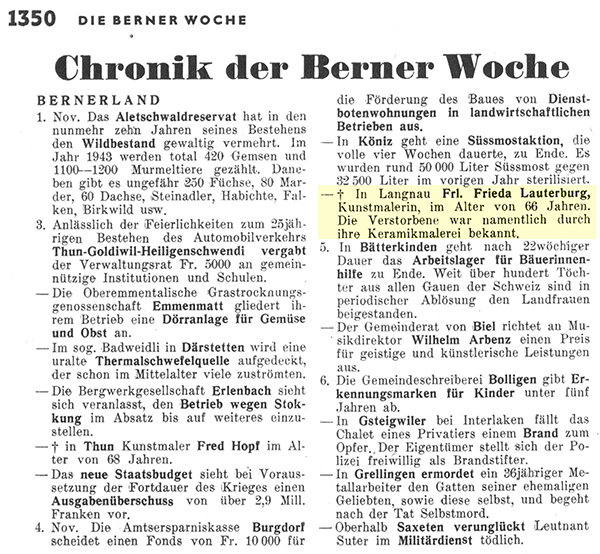
Berner Woche 33, 1943, 1350.
In November 1943, Frieda Lauterburg died of cancer. A brief obituary in the Berner Woche newspaper explicitly mentions that she was renowned for her ceramic painting.
Frieda Lauterburg’s work has not yet been systematically studied or recognised in terms of art history.
Translation: Sandy Haemmerle
References:
Anner 1916
Franziska Anner, Die kunstgewerbliche Arbeit der Frau in der Schweiz, Chur 1916.
Kiefer 1914
Georges Kiefer, 23: Gruppe: keramische und Glaswaren. Schweizerische Landesausstellung in Bern 1914, Fachberichte Band VI.
Messerli 2017
Christoph Messerli, 100 Jahre Berner Keramik. Von der Tuner Majolika bis zum künstlerischen Werk von Margrit Linck-Daepp (1987-1983). Hochschulschrift (Datenträger CD-ROM), Bern 2017.

